A grand jury on Wednesday indicted a 23-year-old man in the shooting death of a teen in South Richmond last year.
Richmond police were called to the 2800 block of Broad Rock Boulevard at 4:22 a.m. on Nov. 20. A 17-year-old male from Richmond was found with an apparent gunshot wound unresponsive on the curb of the road, police said. He was pronounced dead at the scene.

Coe
Police said the victim was dropped off at the location by someone in a vehicle, which left before officers arrived.
Officers also were called to the 5000 block of Snead Road a few blocks south for a report of random gunfire. It was determined that’s where the shooting happened, police said.
Jacquawn Coe, of Richmond, was charged with first-degree murder and use of a firearm.
People are also reading…
Anyone with information is asked to call Major Crimes Detective P. Mansfield at (804) 646-6996 or call Crime Stoppers at (804) 780-1000.
250 photos from the archives of the Richmond Times-Dispatch

In July 1941, children took a homemade cart for a spin along North 19th Street in Richmond. They built the toy in the spirit of “Gasless Sundays,” a means of conserving resources in a national defense drive ahead of U.S. entry into World War II. The cart was fashioned from an orange crate, old baby carriage wheels and scrap lumber.

This December 1952 image shows East Broad Street in downtown Richmond at night.

In June 1968, Toru Yanagida (left) and Ken Seguchi posed at Hillcrest Dairy in Crewe, in Nottoway County. They were learning American farming techniques from the dairy farm’s owners, Mr. and Mrs. Victor Johnson, who were their sponsors. Seguchi was a dairy farmer from Gifu, Japan, and Yanagida was a student in a college horticulture program in Hokkaido.

In June 1977, a crowd lined up for drinks and barbecue chicken at the Virginia Chicken Festival in Crewe, a town in Nottoway County southwest of Richmond. Held on the pavilion grounds of the Southside Electric Cooperative, the annual affair was sponsored by the Burkeville Ruritan Club and the Crewe Kiwanis Club. It attracted state and local politicians — including gubernatorial nominees John Dalton and Henry Howell — among the more than 3,500 attendees that year.

In April 1976, men tended to the roasting planks at the 28th annualshad planking in Wakefield, an event in Sussex County that lured politicians, reporters, campaign workers and others to kick off the electoral season. Sponsored by the Wakefield Ruritan Club, the event historically was a function of the state’s Democrats, but it evolved into a bipartisan tradition.

In July 1977, Christine Bunce, a student at Manchester High School in Chesterfield County, worked in the Chippenham Hospital gift shop in Richmond as a volunteer. The nickname “candy striper” came from the red-and-white striped aprons worn traditionally by volunteers.

In April 1948, James Phillips Schultz supervised a mumbletypeg game played by two youths at the Richmond Home for Boys. Schultz, 81, was the oldest alumnus of the home. To celebrate the institution’s 102nd birthday, alumni, families and children gathered for an afternoon program that included music , games and dancing for the youths.

In September 1959, stable hand Garfield Tillman walked award-winning racehorse First Landing through Meadow Stable, the Caroline County operation of horse owner Christopher T. Chenery. First Landing, the U.S. champion 2-year-old colt in 1958, had been convalescing after an illness.

In March 1964, Native American children left the two-room state-funded school on the Mattaponi Reservation in King William County. An accompanying article reviewed population trends among Virginia’s Indian tribes; there were 22 Mattaponi and Pamunkey children attending the school at the time.
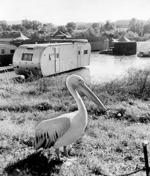
In October 1959, the rain-swollen Rivanna River flooded the Albemarle County Fairgrounds, postponing the opening of a carnival. A pelican that was part of a wildlife exhibit for the event stayed dry while tents and vehicles were under several feet of water.
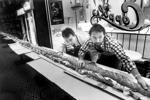
In August 1989, Coppola’s Deli owner Joe Coppola (right) and manager Bill Gerloff carefully assembled a 40-foot Italian hero in the Carytown eatery. The giant sub required three cases of tomatoes, 50 pounds of cold cuts and 15 pounds of provolone cheese. The sandwich was made for the Carytown Watermelon Festival, where patrons could buy 5 inches for $5.
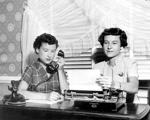
In August 1953, members of the Monacan Junior Woman’s Club sought volunteers for the upcoming blood drive at Tuckahoe Elementary School in Henrico County. While Mrs. Allan J. Carter called prospects, Mrs. William F. Thornton worked at the typewriter.

In February 1962, Richmond started a five-year replacement program for city street signs. The new signs were easier to read.

In October 1957, about 100 firefighters needed four hours to control a blaze in the 700 block of East Main Street in downtown Richmond. The fire caused $100,000 in damage and displaced Nathan’s tailor shop and the DeJarnette & Paul insurance agency.

In December 1942, newspaper delivery boys Arthur (left) and Thomas Purvis of Richmond bought war bonds with money they saved from their routes. Together, the brothers bought 11 $25 bonds from R. Page French, executive vice president of Southern Bank and Trust Co.

In May 1971, Myrtle Palmer (right) taught an exercise class at the Richmond YWCA. Organized in the 1880s, the local chapter of the Y is the oldest in the South.

In November 1989, Academy Award-winning actress Sissy Spacek chatted with Virginia Festival of American Film director Robert Gazzale at an event in Charlottesville. Spacek was on the board of the festival, which debuted a year earlier and eventually was adopted by the University of Virginia. The event is now called the Virginia Film Festival.

In December 1968, passengers waited in the lobby at Byrd Field for outgoing flights. The airport in eastern Henrico County was nearing the end of an extensive expansion to the main terminal.

In April 1947, members of the West Avenue Improvement Association enjoyed a backyard picnic after the first day of the neighborhood’s spring cleanup campaign. From left are R.R. McKaig, Mrs. Granville Coleman and Mr. and Mrs. Chris Payne.

In October 1970, the Richmond Scenic James Council led canoe and walking tours for about 200 people to highlight the natural beauty of the river. Here, Tom Brooks (front) and son Tom Jr. (rear) handled the paddling while Mrs. John Demitri and children Johnny and Lisa enjoyed the view.

In June 1977, Virginia State Penitentiary conducted a 12-hour shakedown and uncovered an array of items hidden throughout the prison, including about 100 “sharpened instruments.” The facility was located along Spring Street in Richmond.

In April 1973, the annual dredging of the James River channel in Richmond was underway. The previous year’s flooding had deposited a great amount of silt, so Atkerson Dredging Co. would be busy. The project, which usually took a week, was expected to require more than a month.

This March 1959 image shows the Richmond skyline from the south bank of the James River.

In March 1971, a crowd estimated at several hundred waited outside City Council chambers at City Hall in downtown Richmond. Residents of the recently annexed Broad Rock area were protesting the Richmond Redevelopment and Housing Authority’s proposal for low-rent public housing in the area.

In February 1965, David Gruver (from left) of the Shenandoah Sky Divers Club landed in Louisa County to hand over pine seedlings to soil conservationist Russell Fisher, Smokey Bear and property owner George Bagby. The club flew about 2,000 seedlings from Waynesboro as part of a watershed development and forestation effort.

In November 1972, Charlottesville locals hunted for treasure at the demolition site of Marguerite’s, a reputed high-end brothel from the 1920s to the 1950s. The building was razed as part of the Garrett Street redevelopment project, and in the debris, visitors had uncovered rolls of old cash, moldy silver certificates and other trinkets.

In August 1952, WAC-WAF recruiting officer Lt. Eileen M. Toomey swore in four newcomers to the Women in the Air Force program. Taking the oath, left to right, were Vida M. Burton of West Virginia and Richmonders Doris Cannon Davis, Mary Lou Keck and Joyce Dodson.

In July 1987, the Arby’s restaurant at 2311 W. Broad St. in Richmond was preparing to move next door into a new, larger building (left). The old space was to be converted into a Dairy Queen that would be owned by the same family that owned the Arby’s. Together, the restaurants would employ about 50 people

In February 1969, Medical College of Virginia nursing students Marsha Penney (left) and Martha Mooney checked equipment. They had joined the U.S. Army Nurse Corps in June 1968, and the Army was covering their tuition, room and board at MCV in Richmond. After graduation, they would begin transitioning from civilian to military life with five weeks of basic training in Texas.

In April 1978, students from Huguenot High School in Richmond worked with director Dave Anderson on a public television series called “As We See It.” Financed by a federal grant, the series shed light on school desegregation across America, with students contributing scripts for scenes. The Huguenot segment was titled “The Riot that Never Was” and included a re-enactment of a tense moment in the cafeteria during the previous school year, which ultimately was resolved.
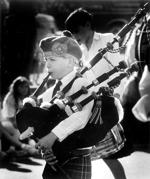
In March 1990, a young bagpiper was part of the St. Patrick’s Day Parade procession on West Broad Street in Richmond.

In December 1990, a Richmond Ballet dancer stretched before rehearsal of “The Nutcracker.”
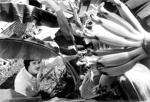
In October 1982, Tim Smith checked the progress of a bunch of bananas in Highland Springs. His father, George, began cultivating the banana grove 10 years earlier after a friend gave him a plant as a gift. The plant grew and multiplied into 89 banana trees, ranging from 6-inch shoots to 18-foot trees. (George Smith said he didn’t eat the fruit — he grew them because he said they were beautiful plants.)

In November 1978, African-American women gathered for a beauty clinic at the Thalhimers at Eastgate Mall in Richmond. The clinic, sponsored by Fashion Fair, brought in beauty professionals, including Pearl Hester (standing at right), to demonstrate makeup techniques.

I
n February 1947, local game warden E.J. Gorman stood atop a dam in one of Chesterfield County’s nine beaver colonies. At the time, two dozen counties had beaver colonies, with an eye toward helping restore fur trapping in Virginia.

In November 1972, after the remnants of Hurricane Agnes had washed out a bridge, a barge carried vehicles and workers across the James River from Tredegar Street toward Belle Isle in Richmond. A day earlier, a welder for Old Dominion Iron and Steel Corp. drowned after a boat carrying him and others capsized on the same route.

In September 1961, the Bellevue Theater marquee on MacArthur Avenue in North Side still read “Closed for the Winter.” Neighborhood Theatre Inc. said there were no plans to reopen the theater, closed since 1960. It became home to the New Dominion Barn Dance, a country music radio show.

In January 1980, the Richmond Bicentennial Commission erected this billboard along Interstate 95 downtown to celebrate the city’s 200th year as Virginia’s capital, which previously was Williamsburg.

In January 1950, Bobby Seal, 15 (left), and Marvin “Kayo” Williams, 14, played billiards on the new table at the Salvation Army’s Red Shield Boys Club, which was in Richmond’s Church Hill.
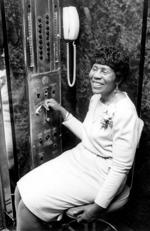
In April 1985, Blanche Whitaker operated the elevator one last time at Central Fidelity Bank in downtown Richmond. Whitaker was retiring after more than three decades and was believed to be the last manual elevator operator in the city. With her departure, the bank planned to convert the elevator to automatic control.

In July 1963, John Adam, director of talking books for the Royal National Institute for the Blind in London, visited Richmond and showed Virginia Library for the Blind employee Mrs. Richard V. Carter a new cassette system for recording and reproducing audio tapes of books. Using a federal grant and tapping into British expertise, the Virginia library was testing the system, whose cassettes offered more capacity and lasted longer than old discs used by blind patrons.

In March 1959, visitors at the Richmond Boat Show inspected a new cruiser, a sort of floating camper, during the five-day event at the State Fairgrounds in Henrico County. It was considered to be the first strictly marine show to be held in Richmond.

In June 1968, workers welded boilers at Old Dominion Iron and Steel Corp., located on Belle Isle under the Lee Bridge in Richmond. At the time, Old Dominion’s owner was interested in expanding operations, and the city was interested in using the island as part of a James River park. The company’s history on Belle Isle spanned from before the Civil War to the 1970s.

In December 1962, a new sign designated the Thalhimers department store in downtown Richmond as a fallout shelter. Sections of the store had been approved to house up to 8,700 people in case of a disaster, and the store was stocked with a two-week supply of food and water, plus medical and radiation measuring equipment. From left are naval engineer D.R. Dorsey, store President William B. Thalhimer Jr. and city safety director William L. Groth.

In July 1960, the Schellenberg family of Highland Springs prepared to have a bomb shelter installed in their yard, one of Virginia’s first privately owned radiation fallout shelters. The enclosure was designed to accommodate up to six people during a nuclear attack. The horizontal steel tank (rear) was 7 feet in diameter and 16 feet long. Once installed, the only elements aboveground would be a domed entrance and air filter and exhaust pipes.

In May 1978, owner Jim Thayer stood outside Borkey’s store on Atlee Road in Hanover County. He planned to highlight the store’s more than 100-year history by ordering products that were sold there in the early days.

In April 1962, organizers of the 31st annual Virginia duckpin bowling tournament waited for scores to be posted at the Willow Bowl, a bowling alley in the Willow Lawn Shopping Center in Henrico County. Charles Rao (center) was tournament director; he was flanked by assistant Bob Winston and Connie Thrift, the first local woman to fire a 200-plus game.

In August 1966, Boy Scouts from Troop 644, sponsored by the Henry Fire Department in Mechanicsville, began a 58-mile James River voyage from Richmond to Jamestown aboard homemade rafts. Eleven boys and four adult supervisors participated in the five-day journey, with only paddles and tide to propel them. The 50-mile trip badge the boys earned would move them one step closer to becoming first-class Scouts.

In April 1973, eight men received the Silver Beaver award from the Robert E. Lee Council of the Boy Scouts of America as part of the council’s 60th anniversary recognition. The service award was presented to adult leaders who made an impact on Scouts in the Richmond and Tri-Cities regions.

In May 1973, local Scouts assembled their tents amid exhibits at the daylong Scout-O-Rama at the State Fairgrounds in Henrico County. In addition to traditional skills of woodcraft, wilderness survival, camping and cooking, the event highlighted Scouting’s growing attention to archaeology, seamanship, aviation, metal detection, TV and space technology, among other topics. More than 2,000 Cub and Boy Scouts attended the event that year.

In January 1956, the Boys Club of Richmond expanded by purchasing the house next door to its North Robinson Street location. Options for the new space included more offices, a library, kitchen, meeting quarters and a basement rifle range. The price of the new building was $10,000.

In May 1954, James River Garden Club members visited the Branch House on Monument Avenue to make final arrangements before the weekend’s flower show. As part of the event, the Antiquarian Society of Richmond also prepared an exhibit of 18th-century furniture in the library of the house.

In April 1966, Mrs. Arch Clegg inspected newly planted flowers on a median along Broad Street in Richmond. Two varieties of holly and more than 1,000 petunias were being planted on Broad Street that week between Adams and Eighth streets. The displays, sponsored by Downtown Retail Associates, were to stay in the planters until fall.

In June 1947, Richmond officials put up warning signs near the city limits on West Broad Street to limit speeding, which was a top traffic concern at the time.

In October 1941, babies slept in the nursery at Brookfield, located on West Broad Street in Henrico County. The home for unwed mothers was the successor to Spring Street Home in Richmond’s Oregon Hill area, which was established in 1874 by the Magdalen Association to help single women and their children.

In July 1980, Matthew J. Robinson Jr., president of Imperial Broom Co., stood in his shop off Jennings Road in Henrico County. He was the fourth generation to run the family operation, which started making brooms in 1900.

In June 1946, Gov. William M. Tuck (left) and U.S. Sen. Harry F. Byrd Sr. stirred Brunswick stew at the dedication ceremony for Pocahontas State Park in Chesterfield County. The park, formerly under the National Park Service as Swift Creek Recreational Area, was changing hands from federal to state control. More than 120 gallons of stew were prepared for the 500 attendees.

In May 1964, Mrs. C.L. Pugh, a nurse at the Medical College of Virginia in Richmond, cared for a burn victim. Large plastic coverings with built-in gloves isolated patients’ beds in the burn ward to prevent infection.

This June 1964 image shows Buchanan School in Richmond’s East End a day before its scheduled demolition. The school opened in 1912. In 1964, the property was purchased by the Richmond Redevelopment and Housing Authority as part of the 17th Street Redevelopment Project. The almost 600 students were transferred to the new Mosby School .
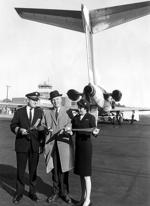
In November 1965, Richmond Mayor Morrill M. Crowe cut a ceremonial ribbon to mark the inauguration of the Eastern Airlines passenger service from Byrd Field to New York. The pilot for the flight, Capt. R.D. Tyler, and stewardess Margaret McLaughlin held the ribbon.

In April 1966, Bernard Sties, chief operator in a local unit of the Chesapeake & Potomac Telephone Co., spoke with operator Barbara Mullins. Sties, then 23, was the first man in the company’s 20th-century history to hold the job; he worked in one of C&P’s four toll units serving the Richmond area.

In August 1981, children enjoyed outdoor recreation at Camp Happyland in the Richardsville area of Culpeper County, not far from Fredericksburg. The Salvation Army started the camp in the late 1950s to improve children’s health through exercise and proper nutrition.
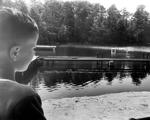
In June 1966, 8-year-old summer day camper Larry Harris surveyed the water facilities at Camp Thunderbird, which the YMCA opened that year in Chesterfield County. For more than 50 years before, the Boy Scouts had operated Camp Shawondasee there.

In August 1971, members of Camp Willow Run gathered outside their dormitories, which were former train boxcars. The railroad-themed camp, on a Lake Gaston peninsula in Littleton, N.C., is still run by Youth Camps for Christ Inc. The dining hall, modeled after an 1890 train depot and built from plans furnished by the Southern Railway Co., was the focal point of activities.

In February 1965, Richmonder John Smook, his wife — and their six children “upstairs” — piled into the family camper for an outdoor adventure. Smook, who also sold the pickup truck campers, said they offered the conveniences of home and protection from the elements while in the wilderness.

In January 1969, Calvin H. Butler, a farmer in Middlesex County on Virginia’s Middle Peninsula, stood by the sign for his new Bush Park Campground on waterfront property he inherited from his father. Butler cleared space in the heavily wooded area for 300 campsites, and his operation offered a range of amenities.

This September 1953 image shows the canal locks in downtown Richmond between 14th and Pear streets. After their installation and later refurbishment in the mid-19th century, the locks increased boat traffic and allowed for easier transport of goods to and from the city.

In July 1951, Alonzo Moore, 74, walked down a street in Cape Charles on Virginia’s Eastern Shore and blew his horn, alerting locals to his sale of the fresh catch of the day.

In July 1951, two women enjoyed the white sand beach of Cape Charles on Virginia’s Eastern Shore.

In August 1963, Steven Suggs of Richmond stood with his antique horse-drawn hearse, part of his collection of old carriages. At the time, Suggs had eight carriages and had spent seven years restoring them — but he had yet to come across any other carriage enthusiasts in Virginia.

In September 1941, amid a nationwide gas shortage, Harry J. Donati (left) and Joseph G. Robben drove their horse-drawn carriage down 25th Street in Church Hill in Richmond.

In July 1947, “The Soldier,” as many people called the patient of Central State Hospital near Petersburg, sat outside a sentry box he had built on the grounds. The psychiatric hospital dates to 1869, when a former Confederate facility known as Howard’s Grove Hospital was designated as a mental health facility for African-Americans.

In October 1975, the Downtown Mall in Charlottesville was in the final phase of initial construction, with some of the square holes in the former Main Street slated to be filled with landscaping. The $2 million pedestrian mall opened in 1976 and, as it marks 40 years in 2016, is home to more than 150 shops and restaurants.

In September 1970, Mrs. M.G. Ratcliff and her son, Steven, of Lakeland, Fla., tried — to no avail — to treat a bull to some cotton candy at the Chesterfield County Fair. The family was visiting relatives in the county.

In September 1985, Timmy Bear took care of last-minute preparations in his game booth as the Chesterfield County Fair prepared to open.

In July 1961, two men fished for bluegills in Chickahominy Lake, a large water-supply reservoir along the New Kent-Charles City county line.

In September 1962, Frederic S. Bocock of the Historic Richmond Foundation and Mrs. Cornelius F. Florman stood in front of one of four new plaques honoring patrons of Church Hill renovations in Richmond. Florman was the granddaughter of Mrs. Richard S. Reynolds; the plaque pictured cited Reynolds’ role in restoring Hardgrove Cottage on North 24th Street.

In June 1955, chemist Jerry Ezekiel used a smoking machine to test cigarette filters at U.S. Filter Corp. in Richmond. Growing interest in filter-tipped cigarettes led to the founding of the company, which was a unit of the London-based Bunzl Group. The plant, located on Petersburg Pike, produced its first filter in January that year.

In March 1971, a crowd estimated at several hundred waited outside City Council chambers at City Hall in downtown Richmond. Residents of the recently annexed Broad Rock area were protesting the Richmond Redevelopment and Housing Authority’s proposal for low-rent public housing in the area.

In August 1954, members of the Richmond Civic Ballet rehearsed for an upcoming performance. The open-membership volunteer group, which presented roughly a dozen performances annually at local events, was organized almost four years earlier by local former professional dancers Betty Carper Grigg and John Hurdle.

In November 1972, the Sears store in Cloverleaf Mall featured new coat and dress styles as well as furs. The Chesterfield County mall opened in August of that year; it closed in 2008, and the building was demolished in 2011.

This 1957 photo shows Collegiate School in the 1600 block of Monument Avenue in Richmond. The Town School elementary building was on the left and the high school on the right. In 1960, the Town School and the Country Day School merged, operating on the campus off River and Mooreland roads in Henrico County. It remains the location today.

In September 1954, presidents of four upper classes at Collegiate School in Henrico County gathered at the entrance to discuss school matters. From left were senior Bernice Spathey, junior Jane Durham, sophomore Dorothy Ewing and freshman Terry Bunnell.

In July 1968, a summer session class of journalism students worked on the yearbook, “The Sunfire,” at Collegiate School in Henrico County.

In January 1965, Colonial Beach workers removed the deck from the town pier on the Potomac River. The pier, which was built in the 1930s to dock river excursion boats, was being demolished after repairing it turned out to be too costly.

In July 1953, Cliff Miller (from left), Al Dickinson and Bob Figg Sr. discussed the Country Club of Virginia’s annual tennis competition, which began the day before. Only Dickinson advanced past the first day of the competition.

In July 1962, workers at a Lancaster County plant inspected crabmeat during a demonstration of a new picking machine, which promised to triple production. The machine was developed by a crabmeat packer in Oriental, N.C.

In August 1969, “Dinks” Thornton (from left), W.E. Nichols and a gloved Sewell Thornton were in Chincoteague preparing for the next day’s National Hard Crab Derby in Crisfield, Md. The men were betting on their prized Creeper X (center), a direct descendant of a line that had given Virginia many wins at past races. The side-stepping speedster and its alternate had been in training for a month.

In December 1986, Irene Dameron stood behind the counter of her Westmoreland County shop with regulars (from left) Bob Prather, Ben Allen and Bob Sanford. Dameron had run the shop for 28 years — she had taken over the business from her father, who ran it for 33 years before that. Though the store’s inventory had been reduced, her loyal customers came in almost every day to pass time, action Dameron encouraged by having benches and chairs in the shop.
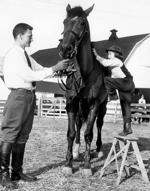
In March 1954, Perry Sinnickson, 8, eagerly mounted a horse with little assistance from instructor Stewart Felvey. They were at the Deep Run Pony Club in Goochland County, a new equestrian program for juniors and the first club of its kind in Virginia.

In December 1964, rolls of newsprint were hoisted from a ship at Richmond’s Deepwater Terminal in preparation for delivery. The Virginia State Ports Authority was hoping to substantially increase trade activity; it had recently opened an office in Tokyo, adding to international locations in London and Brussels.

In December 1976, Freeman and Theresa Spencer sat in their Richmond home with Tillie, their prized 6-year-old German shepherd. The living room featured Tillie’s numerous trophies and memorabilia — at the time, she held titles as an American conformation champion and Canadian conformation champion, among other honors.

In May 1954, Scoop sniffed around the pet food aisle at a grocery store in Richmond’s West End. The store offered a large selection of pet foods, a relatively new concept for the era. The accompanying article said: “Gone, apparently, are the days that Fido took the scraps from the table and liked them.”
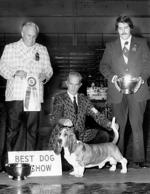
In September 1975, handler Bobby Barlow showed off his basset hound, Champion Slippery Hill Hudson, who was named best in show at the Virginia Kennel Club dog show at the Arena in Richmond. At left is judge George C. Ehmig, and at right is show executive Lawrence W. Bracken Jr.

In August 1982, David Tidwell of Croaker posed with his girlfriend’s dog, Blazing Amber of Cinder, at the humorous “Norge Dog Station” at Norge Grocery on U.S. Route 60 west of Williamsburg. The sign had been put up seven years earlier, and the spot became a popular photo opportunity for visitors.

In August 1965, the All American Touring Band and Chorus performed the finale at the Festival of Arts in Richmond’s Dogwood Dell. The festival, sponsored by Federated Arts of Richmond Inc. and coordinated by the city parks department, lured about 52,000 people to 13 concerts and eight stage productions during the summer.
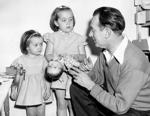
In December 1947, T.E. Burton Jr. diagnosed a patient at his doll hospital on Forest Hill Avenue in Richmond. Burton, a state Highway Department employee, was part-time chief surgeon at the doll hospital he ran out of his home. He got into the repair business when his two young daughters received as gifts antique china dolls that were badly in need of work. Burton averaged about 10 patients a week, with a busy season around the holidays.

In June 1981, Neville D. McNerney led his granddaughter Christi on a ride in Prince George County. The retired Army infantry officer raised, trained and showed mules and donkeys as a hobby. And while the agricultural need had declined, McNerney’s miniature animals were popular for recreational use such as riding and show-ring competitions.

In May 1942, actress-singers Dorothy Lamour (center), Patsy Garrett (at left) and actor Bert Lytell (at right) visited Richmond as part of a rally to stimulate sales of war bonds and stamps. They stood under a “Welcome to Richmond” sign and were flanked by Malcolm Bridges (left), the executive secretary of the Richmond Chamber of Commerce, and Ship Ahoy Girls Jetsy Parker and Dorothy Schoemer. The rally drew more than 5,000 people.

In November 1948, Army Lt. Charles D. Smith Jr. administered the oath to the first set of postwar draftees processed at the Richmond induction station at First and Broad streets. Several of the men were immediately sent to Camp Pickett in Blackstone.

In July 1959, D.K. Owens studied cellophane under the microscope in the lab at DuPont’s plant in Chesterfield County. The factory was developed in the late 1920s to produce rayon and began making cellophane in 1930, a material that used a similar production process.

In July 1959, DuPont scientist Meredith Miller checked experimental cellophane coatings at the plant in Chesterfield County. The factory was developed in the late 1920s to produce rayon and began making cellophane in 1930, a material that used a similar production process.

In December 1944, employees of DuPont’s Spruance plant in Chesterfield County worked to find housing and transportation for company workers. During the war, the women — Mary B. Traylor (from left), Bella C. Hill and Pearl R. Kessler — helped new employees get adjusted to their jobs.

In April 1979, a crowd of 10,000 gathered along Monument Avenue in Richmond for the annual Easter Festival, which included music from the Richmond Pops Band. The festival, sponsored by the Monument Avenue Preservation Society, included dancers, almost 30 art exhibits, children’s entertainment and food.

In June 1943, a sign posted in the elevators of the Atlantic Life Insurance Co. in downtown Richmond challenged tradition by asking men to keep their hats on to speed elevator service and allow for more room.

This February 1986 photo shows Ellwood Farm in Wilderness, along the border of Orange and Spotsylvania counties. The home dated to the 1790s and survived the 1864 Civil War Battle of the Wilderness between Union Gen. Ulysses S. Grant and Confederate Gen. Robert E. Lee. The farm home’s resident, Dr. Gordon W. Jones, had sold and donated the house and many acres of land to the National Park Service.

In spring 1981, the Express Lane drive-thru convenience store opened in Louisa County. Patrons could stay in their cars to assess their choices, then place orders with a “runner” who would retrieve items. The store was patterned after the drive-thru beverage locations on North Carolina’s Outer Banks.

In November 1980, a 1922 firetruck with extension hose was on display at Engine Co. 20 on Forest Hill Avenue in South Richmond. The vehicle, which was in service until 1958, deteriorated for years until local residents and businesses volunteered to restore it.

In December 1957, firefighters battled a blaze at L.R. Brown & Co., a furniture store on Hull Street in South Richmond. The warehouse blaze destroyed many pieces intended for Christmas gifts.

In June 1972, a farm in Columbia, a James River town in Fluvanna County, was largely submerged after the remnants of Hurricane Agnes brought some of the worst flooding in decades to many parts of the state. In Richmond, the swollen James peaked at 36.5 feet.

In September 1935, a small group of men, part of a larger army of workers and 70 trucks, reinforced dikes with sandbags to protect the 5-mile area controlled by Richmond’s Shockoe Creek Pumping Station from flooding caused by a severe storm.

In April 1970, Mr. and Mrs. Kenneth J. Lee demonstrated the steps for classmates H.G. Shaw and W.W. Foster in a local folk dancing class.

In October 1951, workers constructed a section of Forest Hill Avenue in South Richmond. The segment sits between Westover Hills Boulevard and Prince Arthur Road.

In August 1945, Richmond News Leader reporter Irene Stickler got her palm read by a fortune teller at the newspaper office. For a story, Stickler got her fortune told by six area psychics and compared their interpretations of her past, present and future.

In April 1977, workmen removed the fountain from its foundation in Monroe Park in Richmond. A replacement, cast from a mold of the old one, was to be made by an iron company in Alabama and installed during the summer.

This 1966 image of a quiet night on Franklin Street in downtown Richmond was captured by Times-Dispatch photographer David Harvey, who became renowned for his National Geographic magazine work and has received national awards. His photographs have been exhibited nationwide, including at the Museum of Modern Art in New York and the Virginia Museum of Fine Arts locally.

In March 1952, Mrs. V.C. Wiltshire, 85, prepared for spring planting at her home on Patterson Avenue in Richmond.

In January 1970, Virginia Gov. Mills E. Godwin Jr. received his final salute from state police as he and his wife, Katherine, left the Executive Mansion in Richmond en route to the inauguration of A. Linwood Holton Jr. Godwin, then a Democrat, returned as governor four years later as a Republican.

In November 1961, Gov.-elect Albertis S. Harrison Jr. sat with wife Lacey (right) and daughter Toni. In a profile about the rising first family of Virginia, the three shared that they enjoyed playing bridge together, and Toni said she liked playing golf with her father while quizzing him about political affairs.
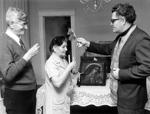
In January 1972, the Rev. Constantine N. Dombalis, leader of Saints Constantine and Helen Greek Orthodox Church in Richmond, sprinkled holy water on the foreheads of two parishioners at the beginning of his tour to perform blessings of the homes for his 300 parishioners.

In June 1956, the Rev. Lawrence V. Bradley Jr. of Grove Avenue Baptist Church in Richmond and his secretary, Jean Bolton, got out the summertime heat beater: a simple cardboard fan. The pews were liberally stocked during the warm months because the church had no air conditioning.

In October 1976, Hampden-Sydney College students stayed in motel-style units that were constructed to accommodate them while older dorms were renovated. Each of the four buildings had eight rooms, with two students to a room.

In June 1960, Harry L. Donovan (dark suit), his handcuffs covered by a jacket, was escorted from the U.S. Marshal’s Office in downtown Richmond, en route to a four-year term in federal prison in Atlanta. For decades, Richmond was the center of Donovan’s numbers operation; he pleaded guilty to multiple counts of failing to pay wagering taxes.

In March 1969, a sign went up to mark the site of Henrico County’s first permanent designated library, on Laburnum Avenue near New Market Road. On hand were (from left) Varina District Supervisor Edwin Ragsdale, library board trustee Mrs. F.M. Vaughan, library assistant Virginia Liles and county libraries director David Rowland. The library opened in December 1970.

In March 1987, in preparation for new carpeting, the Dumbarton branch library in Henrico County had to remove about 80,000 books from shelves. About 50 people handled the first phase overnight — but restocking the shelves awaited.

In November 1977, Henrico County sheriff’s deputies Thomas N. Jackson (left) and William A. Brown graduated from the Richmond Bureau of Police Canine Academy. The two deputies — along with Sparky, Jackson’s male German shepherd — became Henrico’s first K-9 patrol after completing 14 weeks of training.
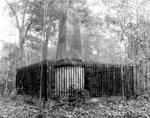
This November 1971 image shows a monument in eastern Henrico County that commemorated the “calamitous year 1771” flood in Richmond. On another side, the monument included an inscription from Ryland Randolph citing 1772 and memorializing his parents.

In March 1952, the new Highland Springs High School in Henrico County was under construction; it opened for classes in September and cost about $1.2 million. The previous building, which housed elementary and high school students, became solely an elementary school in its reopening.

In September 1963, members of the Historic Richmond Foundation examined homes in the 2300 block of East Broad Street. The Church Hill homes, known as Carrington Row, were in the early stages of restoration by the foundation.

This November 1955 image shows the iconic Hofheimer building at 2816 W. Broad St. in the Scott’s Addition area of Richmond. The building, with a distinctive Mediterranean-style roof and minaret, was built in 1928 by Herold R. Hofheimer to house his business, Hofheimer Rug Cleaning & Storage Co.

In May 1991, construction was continuing on the mausoleum in historic Hollywood Cemetery in Richmond. The facility, built to accommodate 735 caskets and 160 cremation urns, was dedicated in May 1992.
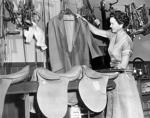
In July 1954, Mrs. Arthur Franklin worked on a display at Jeter’s, her harness shop at 221 E. Main St. in Richmond. The shop was founded in 1888 and had been a supplier of saddles and bridles for Abercrombie & Fitch, the New York sporting goods house. By the 1950s, a key customer was Colonial Williamsburg: It equipped its horses with harnesses and other accessories made by Jeter’s in strict accordance with 18th-century design.

This March 1966 image shows the Hotel Richmond, which was acquired by the state in June that year for about $2 million and is now used as its Ninth Street Office Building. The hotel, adjacent to Capitol Square, was established in 1904 by Adeline Atkinson at the location of the former St. Clare Hotel.

In October 1982, Hull Street Station in South Richmond was vacant and boarded up — the last regular passenger train to Danville had left 25 years earlier. The Southern Railway donated the station to the Old Dominion chapter of the National Railway Historical Society, which planned to convert the space into a museum and library. It now houses the Richmond Railroad Museum.

In October 1986, preservationist and author Jim DuPriest led a tour of Richmond’s Jackson Ward neighborhood for 45 students from Luther Memorial School. The school was founded by German immigrants in 1856 at a time when the neighborhood had a notable German population; Jackson Ward later became one of the nation’s leading African-American communities.

In July 1979, Shirley McCoy performed a gospel number at a Jackson Ward reunion. The gathering at the Empire Theater brought together several hundred former residents and business owners of the Richmond neighborhood for a night of performances and community recognition.

This July 1964 image shows the James River from an overlook along the Blue Ridge Parkway. At the time, Lynchburg engineer W. Martin Johnson, a proponent of river development who was president of the James River Basin Association, was urging exploration of how industries could benefit from the river’s watershed of roughly 10,000 square miles in the state.

In January 1978, Bill Heindl, a co-founder of the Heindl-Evans Inc. construction firm, oversaw progress on building a footbridge in James River Park at Texas Avenue in Richmond.
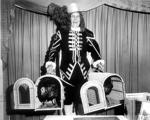
In November 1961, state Sen. John J. Wicker dressed as a colonist and, having flown to Boston, presented the governor of Massachusetts with documents — and live turkeys — to make the case that Virginia held the first Thanksgiving in 1619, two years before the Pilgrims held a celebration at Plymouth.

In October 1969, cadets at John Marshall High School in Richmond posed with their ribbon-bedecked sponsors after an awards ceremony. The school’s Corps of Cadets was established in 1915 — it was the first military training program in a public school in Virginia — and disbanded in 1971.

In January 1978, Mrs. W. Thomas Cunningham Jr. installed a door ornament at the new headquarters for the Junior League of Richmond: the Mayo-Carter House at 205 W. Franklin St. downtown.

In June 1976, cars and other scrap metal awaited shredding at Peck Iron and Metal Co. Inc., located off Commerce Road in South Richmond. A large machine called a fragmentizer could chew up a car and spit it out as tiny chunks of metal in about 40 seconds.

In June 1979, Terry Woo set bricks for a walkway as construction of Kanawha Plaza in downtown Richmond continued. The $4 million dollar city-financed plaza linked the Federal Reserve Bank of Richmond building and the Virginia Electric and Power Co. building.

In May 1950, Clifford Burgess (from left), Harlean Bibb, Charles King and Shirley Kingsley, who attended Summer Hill School in South Richmond, practiced a square dance called “Duck for the Oyster.”

In late April 1975, landscape workers prepared gardens in front of the Eiffel Tower replica at Kings Dominion in Doswell. The theme park opened days later on May 3.

In July 1954, Kitty Liles performed with her band. Liles had played the drums for years, starting when she was a student at Varina High School in the 1940s. In 1954, Liles was using money from her gigs around Richmond to pay for her pursuit of a social work degree at Richmond Professional Institute.

In September 1985, NASCAR Cup driver Kyle Petty inspected his wrecked Ford Thunderbird after a practice session at the half-mile Richmond Fairgrounds Raceway during the Wrangler 400. Petty’s car hit Dale Earnhardt’s, with Petty getting the worst of it.

In August 1947, patrons of a Richmond laundromat played bridge while their clothing was in the machines. The new coin-operated laundry facilities saved time, as a half-day chore without machines at home was reduced to a 30-minute cycle. The laundromat also became a social gathering place.

In April 1963, Laura Vietor was recognized for her longtime nursing work at Sheltering Arms Hospital in Richmond. She was awarded the Elizabeth D. Gibble Volunteer of the Year Award for her many years of service, which included full-time volunteer nursing even after retiring at age 65.

In September 1963, Jay Puryear examined an old traction engine, a forerunner to the farm tractor, which had been gifted to the city through the Richmond Chamber of Commerce. The engine was to appear in the Tobacco Festival parade the following month and then be displayed at Parker Field in a special exhibit on transportation.

In June 1962, Lois Snider, an office manager at Richmond insurance agency Alsop & Elliott, tested a new machine as part of an industry-sponsored pilot program. The machine, developed by Friden Inc., aimed to expedite policy writing, data collection and other office work at agencies across the country.

In January 1961, H.W. DeMille, manager of the Richmond office of Hardware Mutual Sentry Life Insurance Group, demonstrated the “Data-Phone” used by his company. The new Bell System service allowed business machines to communicate quickly over phone lines. For the insurance company, that meant faster processing of information between headquarters and branch offices.

In July 1961, Gordon Burks, an electrician for Union Electric Co. Inc., used a new machine to saw out segments of sidewalk in downtown Richmond, where the company was replacing traffic lights. The saw blade, which was studded in industrial diamonds, cost $185 (about $1,500 in inflation-adjusted pricing in 2016).

In November 1961, William Radvany, the meat manager at Capitol Food Market on East Marshall Street in downtown Richmond, demonstrated a new $12,000 machine that aimed to save the butcher a lot of work: It wrapped, weighed, labeled and priced meats.

times-dispatch
In December 1947, Charles C. Slayton (left), president of the Society of American Magicians, was the target of a card trick when Dan Friedman pulled an oversized deck of cards from Slayton’s vest pocket during an event at The Jefferson Hotel .

In June 1977, John Stevens and his long-eared assistant performed a magic trick. Known as Nabis the Magician, Stevens was among the Richmonders in the International Brotherhood of Magicians. The local chapter had 25 members who met regularly to discuss their craft.

In June 1949, Carl A. Throckmorton (left) showed Richmond Postmaster Fergus McRee one of the 100 new mailboxes that would be installed at city street corners. The additions would bring the total number of receptacles to about 680, meaning no city resident would have to walk more than three blocks to deposit a letter.

In September 1950, Sherry Gilman placed a letter in a barrel-turned-mailbox on Honaker Avenue in Richmond. The barrel was serving as a temporary mailbox for the newly developed residential area in the West End.

In October 1951, Mrs. R.L. Mattox showed off the unique mailbox at her home in Prince George County. The mailbox post was made using an old log cabin chain and required an hour’s worth of welding. Mattox and her husband were inspired by a design they saw in a magazine.

In August 1963, June Hudnall (left), head nurse of the Medical College of Virginia Hospital’s Clinical Research Center, connected an artificial kidney to a patient who was a transplant candidate. Dr. John Bower and Barbara Hale are at back. The research center focused on patients warranting intensive study, including those slated to undergo rare operations.

In October 1974, J.G. Adams, the Southern regional distributor manager for Litton Microwave Ranges, demonstrated microwave cooking and touted its benefits during a program at the Miller & Rhoads department store in downtown Richmond. He prepared several dishes — and assured people with shielded heart pacemakers that microwaves posed no danger.

In June 1961, cartons of homogenized milk were stored in a cooling room at Richmond Dairy Co. before being delivered to homes and stores. The company was located in Jackson Ward; the plant, with its unique milk bottle façade, is now an apartment building.

In December 1963, a milkman delivered informational pamphlets about polio in addition to milk. In the 1930s, economic pressures caused dairy farmers to begin the Milk Wars, in which they would withhold product to try to drive up the value of milk.

In April 1947, Ed Brooking, the 68-year-old proprietor of the Cedar Point Grist Mill in Goochland County, loaded corn into a funnel to be ground by the millstones. While his machine was old and often required maintenance, Brooking swore by the method of stone-ground corn.

This February 1952 photo shows Muddy Creek Mill in Cumberland County. The water-powered mill dated to the late 1700s and is listed on the National Register of Historic Places.
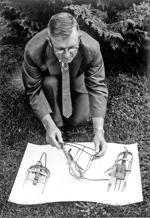
In 1963, Virginia Polytechnic Institute Associate Entomologist J.M. Amos demonstrated a mole trap. Though he said moles weren’t a gardener’s top enemy, their runways were used by other rodents that eat plant roots or bulbs.

In June 1969, a Trappist monk at the Holy Cross Abbey near Berryville in Clarke County began his daily meditation. The monks spent their days balancing quiet prayer, spiritual reading and manual labor.

Above: In May 1969, an informal folk gathering brought a crowd to Monroe Park in Richmond. Composer Dan Riddick and a group of guitarists from Washington performed; guests were asked to bring toys and clothing for needy residents in Washington. Left: In October 1986, preservationist and author Jim DuPriest led a tour of Richmond’s Jackson Ward neighborhood for 45 students from Luther Memorial School. The school was founded by German immigrants in 1856 at a time when the neighborhood had a notable German population; Jackson Ward later became one of the nation’s leading African-American communities.

In March 1969, balmy weather drew a large crowd to Monroe Park in downtown Richmond. A small band joined the gathering, serenading visitors as spring arrived.

In November 1951, workers constructed a new lane on Monument Avenue in Henrico County. The truck was occupying what used to be the front yard of a house in the 6500 block. The road was being widened for divided lane traffic in the block between Bevridge Road and Roxbury Road.

times-dispatch
In August 1967, morning commuters driving along Monument Avenue near the Henrico County and Richmond border welcomed a break in the clouds and some sunshine after a week of continuous rain.

In October 1976, architect Robert Winthrop held a brick believed to be from the 1811 Richmond Theatre fire. Winthrop was working on the restoration of historic Monumental Church, which was built on the theater site on East Broad Street as a memorial to those who died in the fire. The restoration work uncovered burned bricks and traces of the original theater wall.

In June 1986, Historic Richmond Foundation leader John G. Zehmer Jr. (center left) reviewed roof plans with architect Kenneth MacIlroy at Monumental Church on East Broad Street in Richmond. The historic church, built as a memorial to those killed in the 1811 Richmond Theatre fire, was getting a new copper roof as a step toward preserving the building.

In April 1949, Richmond Mayor W. Stirling King threw out the first pitch at the Richmond Colts’ home opener at Mooers Field. At right, wearing the new home uniform, is Colts manager Vinnie Smith. At left is Ray Schalk, manager of the Newport News Dodgers. The Colts were members of the Piedmont League from 1933-53 and moved to Colonial Heights in 1954 when Richmond obtained a Triple-A franchise, the Richmond Virginians.

In October 1948, families and city officials attended a program at the Mosque pool in Richmond, which had just opened for the season. Highlights included a synchronized swimming exhibition as well as swim safety instruction. The pool was in the basement of what is known today as the Altria Theater.

In June 1952, motorcyclists raced in the 10-Mile National Motorcycle Championship at the Atlantic Rural Exposition grounds in Henrico County. More than 4,000 spectators saw Bobby Hill of Columbus, Ohio, the nation’s top racer, ride bike No. 1 to victory in the 20-lap championship race.

In May 1950, motorcyclists raced in the 10-Mile National Motorcycle Championship at the Atlantic Rural Exposition grounds in Henrico County. The winner was “Little Joe” Weatherly of Norfolk, who later turned to stock car racing and won NASCAR titles in the 1960s before being killed in a race accident in Riverside, Calif., in 1964.

In June 1986, “Mr. Newspaper” greeted a young girl and her mother at a Richmond-area mall. The RTD mascot often traveled around town promoting the newspaper.

In April 1978, John Stone plowed a field on a tobacco farm in Union Level in Mecklenburg County. Owner Joe Warren of South Hill used seven mule teams to plow 60 tobacco acres among several of his farms.

In May 1971, Mrs. Henry Heatwole (left) and Agnes Crandall served the National Park Service at Big Meadows, part of Shenandoah National Park. The previous year, the service instituted a program allowing use of volunteers for interpretive and other services. Heatwole had established a library at the park; Crandall, also an experienced volunteer, had recently become a paid employee.

In May 1989, a transformer exploded under the sidewalk on the Fourth Street side of the Richmond Newspapers Inc. building downtown. The ensuing fireball charred two cars parked on the street and sent flames up the side of the building. No one was hurt in the nighttime explosion, and delivery of the next morning’s Richmond Times-Dispatch (which was printed in the building) was only slightly delayed.

Left: In July 1967, members of the Nolde family — Henry, from left, George, Carl and Arthur — watched bread roll off the assembly line at the Nolde Bros. Bakery in Church Hill in Richmond. Their relatives started a small baking operation in the 1890s, and by 1950 three area Nolde plants produced almost a million loaves per week to be sold nationally. Nolde closed in 1977. Right: In July 1979, Shirley McCoy performed a gospel number at a Jackson Ward reunion. The gathering at the Empire Theater brought together several hundred former residents and business owners of the Richmond neighborhood for a night of performances and community recognition.

In December 1941, Mrs. Frank Sloan of the Red Cross took dictation from soldier Robert Parks in the convalescent ward at the Camp Lee Hospital in Prince George County. She was among two dozen women from the Richmond and Tri-Cities areas who had just become Gray Ladies, a hospital volunteer branch of the Red Cross.

In April 1954, P.R. Webb, a worker at the O.K. Foundry, loaded small castings into a cleaning machine at the company’s new location at 1005 E. Ninth St. in Richmond. Established in 1913, the foundry made machine castings for the tobacco, paper and agricultural industries.

In June 1948, Hans E. Gassman, an employee of the Virginia Museum of Fine Arts in Richmond, restored a painting by Dutch artist Ferdinand Bol. Gassman, originally from Italy, had 15 years of experience repairing paintings. The tedious process required painting skills as well as knowledge of chemistry, since solvents were used to loosen old paint for replacement.

In June 1941, Patrick Henry’s “Give me liberty or give me death” speech was re-enacted at St. John’s Episcopal Church on Church Hill in Richmond as part of its bicentennial celebration. Construction of the church, built on land donated by city founder William Byrd II, was completed in June 1741.

In September 1948, Richmond actress, singer and national radio show host Patsy Garrett greeted a friend downtown during her visit here. Garrett was known for her time on Fred Waring’s “Pleasure Time” radio show in the 1940s and for her recurring film and television roles in “Nanny and the Professor,” “Room 222” and the “Benji” movie series.

On Sunday, visitors to Shockoe Hill can determine if they have ancestors buried there.

In August 1972, William A. Richards, president of the Piccadilly Cafeteria chain, donned a chef’s cap and apron for a restaurant opening in the new Cloverleaf Mall in Chesterfield County. It was the second Piccadilly in the state; the first was in Norfolk.

In June 1951, the summer heat sent crowds to Pocahontas State Park in Chesterfield County for a swim. Earlier that month, the state’s nine parks welcomed more than 77,000 visitors during their unofficial opening week for the season.

In November 1982, a crowd filled Regency Square mall for the first day of Sunday store openings in Henrico County. Before the Sunday closing law, or so-called blue law, was formally repealed by the Board of Supervisors, Henrico residents — who in a referendum that month voted in favor of repeal — had to travel to surrounding localities to shop on a Sunday.

In September 1969, members of the Thomas Jefferson Garden Club tended to the Enchanted Garden at the Edgar Allan Poe Museum in Richmond. The club maintained the landscape at the museum for many years and, in 1985, won an award from the Virginia Federation of Garden Clubs for its efforts. The Poe Museum is just a few blocks from the writer’s first Richmond home.

This September 1965 image shows the Enchanted Garden at the Edgar Allan Poe Museum in Richmond. Just a few blocks from the writer’s first Richmond home, the museum contains an extensive collection of Poe manuscripts, memorabilia and more.

In January 1975, Henrico County police officer Jim Phillips stepped out of a plane used for the county’s sky patrol. The special force played a key role in the capture of three armed bank robbers.

In November 1970, a Richmond officer rode his horse by the police bureau’s new stables, which were under construction. The facility near Brook Road and Chamberlayne Avenue included eight stalls, a scrub area, a horseshoeing area and a tack room. The bureau had been looking for an established home for its horses since the mid-1960s, when the Virginia National Guard moved from the Richmond Howitzers downtown armory, where the horses had been stabled for two decades.

In March 1948, W.J. Peacentini (from left), Lt. L.P. Tyler and L.C. Priddy watched M.E. Williams sink a ball during a game of pool at Firehouse No.7 on East Cary Street in Richmond. The pool table was the center of recreation for many firefighters waiting for the alarm.

In February 1977, former California Gov. Ronald Reagan greeted young admirers during a visit to Richmond. His 66th birthday coincided with his appearance at a reception for Del. Wyatt B. Durrette Jr. (next to Reagan), who was seeking the Republican nomination for attorney general.

In October 1980, Ronald Reagan, at the time the Republican nominee for president, hoisted Brady Spindel, 8, of Portsmouth, during a rally at the Norfolk Scope coliseum. More than 4,000 Reagan supporters attended.

In March 1983, Tommy Ferguson prepared his entry for a race hosted by the Richmond Radio-Controlled Car Racing Club. Nearly 30 cars raced on a small-scale 275-foot asphalt track, buzzing around at nearly 40 mph for an audience of more than 200 people in the parking lot behind Valle’s restaurant.

In June 1958, Reynolds Metals Co. employees Ethel Blue (left) and Bonnie Foy enjoyed some sun at the company’s new office space in Henrico County. The $10 million complex sprawled over 40 acres on a 160-acre property. Reynolds spent more than $150,000 on landscaping, including more than 10,000 trees, shrubs and plants as well as a greenhouse that supplied fresh flowers for the building.

In May 1976, a line wrapped around and beyond the Richmond Coliseum as tickets went on sale for an Elvis Presley concert — about 3,000 people were waiting when ticket windows opened at 10 a.m. His sold-out show in June was his final appearance in Richmond; he died in August 1977.

In July 1940, a Richmond Colts batter headed to first base while a teammate scored in a victory over the Norfolk Tars in a Piedmont League game at Tate Field, which was on Mayo Island in Richmond.

This March 1971 image shows the Richmond Dairy Co. building on Marshall Street in Jackson Ward. Equipment was being auctioned in the four-story building after the company stopped operating in 1970. Dairymen J.O. Scott, A.L. Scott and T.L. Blanton started the company in 1890, and the 1914 building was designed by the architecture firm Carneal & Johnston. Today the building contains rental apartments.

In May 1953, shoppers crowded downtown streets for Richmond Day, a promotion that began the year before. Like Black Friday, the event lured shoppers to stores with deals, such as $1 televisions, 2-for-1 car deals and $1 dresses. Merchants reported strong sales.

In December 1938, Richmond Glass Shop had a new home at 814 W. Broad St., site of the old Ashland Railway Station. The shop, run by brothers Frank R. and A.G. Bialkowski, had glass of many types, and offered bath and kitchen installation, storefront construction and paint products.

In October 1963, members of the Richmond Home for Ladies prepared a banquet cloth for the home’s 80th anniversary. The elder care facility for women was established downtown in 1883 by local physicians and clergy, and it later moved to Stuart Avenue. It is still in operation as Covenant Woods, which moved to Hanover County in 2001 and expanded its mission to include men and women.

In July 1959, the normally bustling downtown Richmond business district, including this stretch along Eighth and Main streets, was much quieter as motorists stayed home because of triple-digit heat.

This May 1965 image shows a section of East Broad Street in downtown Richmond after an evening storm.

In April 1972, Mrs. Peter B. Bahler (left) and Mrs. Jay J. Levit showed off “Vive la Symphonie” buttons that were given to season ticket subscribers for the Richmond Symphony’s upcoming concert season, which would have an international flavor and be led by French conductor Jacques Houtmann. Bahler designed the blue, white and red buttons; Levit led the season ticket campaign.

In July 1979, two boys walked along the rocks in the James River near the Lee Bridge in Richmond.

In May 1968, Richmond Newspapers employees worked in the computer center housing the NCR 315, which eliminated some manual tasks in areas such as billing, payroll, classified advertising and circulation. The system was leased from the National Cash Register Co. and was “likely to meet our needs for at least 10 years — and maybe forever,” the center’s manager said at the time.

This December 1973 photo shows the front counter in Roaring Twenties, a new restaurant and nightclub on state Route 10 in the Hopewell area. It was designed to resemble a 1920s speakeasy, with features including an antique cash register, a diving girl and even a dining table from Al Capone’s Florida home.

In January 1958, Judy Moss, a Hermitage High School freshman, took a spin on roller skates as she practiced her routine at the Arena, a roller-skating rink at Boulevard and Hermitage Road. At the time, Judy was one of the most promising skaters in the Richmond area and was working to master some of the most difficult tasks of the rink.

In July 1956, Warren Collazzo and Pat Benedict of the Eastern Parkway Skating Club in Brooklyn, N.Y., practiced a routine they would use in an international skating competition that was underway at the Arena in Richmond. The multipurpose venue at Boulevard and Hermitage Road hosted sporting events, concerts, shows and exhibitions for more than 40 years before being torn down in the late 1990s to make way for Sports Backers Stadium.
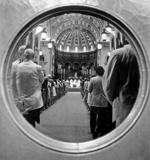
In June 1973, the pews were full at Cathedral of the Sacred Heart in Richmond for a service marking the 50th anniversary of the ordination of the Most Rev. John J. Russell, retired bishop of the Catholic Diocese of Richmond.

In February 1966, a front-end loader moved a new batch of salt that would be used to melt snow on Richmond streets. The stockpile, which had been severely depleted during the first part of winter, was kept at a railroad trestle in the Public Works Department area near Parker Field.

In February 1966, a front-end loader moved a new batch of salt that would be used to melt snow on Richmond streets. The stockpile, which had been severely depleted during the first part of winter, was kept at a railroad trestle in the Public Works Department area near Parker Field.

In April 1967, Salvation Army trainees Mary Dell Parker, Patty Breedlove, Carole La Rue and Barbara Nelson sang from the organization’s songbook. The young women were visiting Richmond from other Salvation Army schools around the country, and they performed at rest homes and other Salvation Army institutions during their stay.

In May 1952, Salvation Army workers in Richmond operated a new machine that cut newspapers into narrow strips for use in packing china, glassware and other breakables. The machine could shred about a ton and a half of material in a day.

In August 1954, Melvin Doggett (left) and Jeff Martin sought relief from the summer heat … by getting even hotter. The men used the “hot boxes” at the Richmond YMCA, which could be set to 115 degrees and could leave the body cleansed and refreshed.

In October 1968, the public got a look at Royal Orchard, a 4,000-acre castle estate atop Afton Mountain. The home, also known as Scott’s Castle, drew more than 4,500 people in a tour to benefit the Crozet Volunteer Fire Department and the Waynesboro First Aid Crew. The home was completed in 1913 by Frederic W. Scott, a Richmond financier whose gifts included the University of Virginia football stadium.

In August 1972, motorists approaching construction on Interstate 64 south of Bryan Park in Richmond were greeted by a robot signalman waving a bright red flag. “Silent Sam,” as the decoy was nicknamed, was used by the state Department of Highways to slow drivers as they neared workmen building an I-195 interchange and bridge near the Acca rail yards.

In October 1985, the Snake-Handlers were booked for a Halloween performance at Rockitz, located at Laurel and West Broad streets. Members of the Richmond band posed in their “monster room,” which was covered in monster-movie memorabilia dating back to the 1960s. Band members were John Cecka (front), Jim Thomson (left), Jeanne Freeman (center), Ron Curry (kneeling) and Tim Harriss (right).

In October 1985, the Richmond band the Snake-Handlers were booked for a Halloween performance at Rockitz , located Laurel and West Broad streets. The band posed in their “monster room,” which was covered in monster movie memorabilia dating back to the 1960s. Band members were John Cecka (front), Jim Thomson (left), Jeanne Freeman (center), Ron Curry (kneeling) and Tim Harriss (right).

In January 1964, traffic on East Broad Street in Richmond moved slowly after the city received more than 4 inches of snow.

In July 1988, Soap Box Derby contestants made last-minute preparations before the race in Richmond. The derby, sponsored by the Richmond Jaycees, was held on Byrd Street between Fourth and Ninth streets.

In October 1977, Bruce Buhrman (left) and Paul Soble stood in front of their soon-to-be restaurant, Soble’s, in Richmond’s Fan District. The building previously housed Cavedo’s Drug Store, which opened in 1916 when the area was sparsely settled. Soble had been a physical education teacher at Tuckahoe Junior High School but resigned so that he and Buhrman, who had tended bar together, could develop the restaurant.

In June 1962, members of the Dixie Girls Softball League prepared to start the league’s 25th season at Byrd Park in Richmond. From left are Lucy Clark, Eleanor Clark, Jane Rapp and Joyce Waddell.

In September 1950, ground was broken for the South Richmond Health Center at 14th and Bainbridge streets. Members of the Richmond public health community and South Richmond Community Nursing Service participated in the ceremony. The clinic, which opened in January 1952, was staffed by volunteer nurses.

In May 1944, Peggy Peisil and Leonard R. Thompson enjoyed the spring weather and lounged in the grass at Capitol Square in Richmond.

In June 1951, square dance caller Richard Chase taught playground directors some steps in preparation for a dance scheduled for the Byrd Park tennis courts in Richmond as part of Park and Recreation Week. The program was organized by the city and sponsored by Thalhimers.

In September 1972, Rudy Peele (left) and Al Sanders shared a laugh at the Virginia Squires rookie tryout camp in Richmond. About 16 players were expected at the camp, including four who were invited after doing well at an open tryout in Norfolk the previous week. That tryout attracted 81 players who hoped to join the American Basketball Association team.
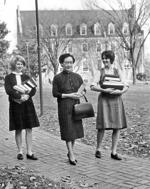
In November 1964, St. Catherine’s School students Cindy McDonough (left) and Rozzie Kemper (right) accompanied teacher Lucile Tang Liu to class. Liu, the new Upper School librarian and a French and Chinese history teacher, was from China and moved to Richmond from Montreal as one of several international teachers added to the school faculty.

In April 1979, the St. Mary’s Hospital Orchestra rehearsed in the hospital auditorium in Henrico County. The orchestra, which formed in 1966 and initially consisted of staff doctors and hospital employees, performed several public concerts a year at the hospital.

In July 1968, Mrs. Robert T. Oliver operated a machine that graded, cleaned and packaged eggs at Oliver Egg Farm in Nottoway County. She was demonstrating the machine as part of a farm and industry county tour sponsored by Fidelity National Bank of Blackstone. About 100 local businessmen and farmers attended.

In March 1979, corrections officer Howard Alexander held the homemade rope used by convicted murderer Michael Irwin Cross to escape from the State Penitentiary, then located along Spring Street in downtown Richmond. Cross was captured two months later after attempting to free a fellow convict who was being treated at Medical College of Virginia Hospital.

In February 1973, prisoners at the Virginia State Penitentiary made and stacked license plates. The pen was along Spring Street at Second Street in downtown Richmond. A print shop, metal shop, textile plant, leather shop and woodworking area offered vocational training to prisoners. Today the site is largely occupied by Afton Chemical Corp., a unit of NewMarket Corp.

In May 1972, an inmate at the State Penitentiary, then located along Spring Street in Richmond, painted in his cell. His portraits were among 200 pieces of prisoner artwork that were displayed at the Carillon Art Show that month. About 20 inmates were members of the penitentiary’s Academy Art Club.

In February 1953, Richmond Department of Utilities workers used a 65-foot hook-and-ladder firetruck to install new lights on Broad Street after attempts to secure other ladder equipment from private companies had failed.

In July 1959, cars were parked along 17th Street in Richmond looking toward Main Street.

This May 1947 image shows a street scene on Main Street near Ninth Street in downtown Richmond. At the time, cars shared the road with electric streetcars. Two years later, with the increase in buses and automobiles, the streetcar system was replaced.

In June 1944, Richmond street sweepers wielded brooms along Adams Street. They were among the first 28 African-Americans hired by the city for the previously all-white field of employment.

In July 1965, employees of M&B Headwear Co. Inc. picketed outside the Richmond factory, one of the country’s largest suppliers of military caps. The strike involved about 300 members of the United Hatters, Cap and Millinery Workers International Union, which was seeking a roughly 15-cent-per-hour raise over two years for some workers. The union said the average hourly wage for the employees, most of whom were women, was $1.35.

In March 1969, St. Mary’s Hospital nurses used the Teachmobile, a cart that moved among floors and allowed workers to learn without relying on large group gatherings. Jeanne W. Orr (left), director of the hospital’s continuing education program, designed the cart with display boards and a tape-recorded lecture. With her is Mary Anne Cook. The Teachmobile was constructed from a flower cart by the hospital’s carpenter.

In April 1985, Cammie Joyce, a daughter of Dr. William H. Parker for whom the former Parker Field was named, threw out the ceremonial first pitch at the new Diamond on opening night for the Richmond Braves. The new baseball stadium on the Boulevard replaced Parker Field.

In May 1946, Capt. John E. Brior, commanding officer of the Richmond Induction Center, sat in the seats that once were filled with wartime draftees. At the time, Congress was debating aspects of extending the Selective Service Act.

In July 1961, a local corporation purchased buildings at the northeast corner of Seventh and East Broad streets in downtown Richmond. The purchase included the National Theater and other properties; tenants continuing to occupy their quarters included Stein’s men’s clothier, Pat’s Record Shop and Stonestreet Brothers Jewelers. An idea of putting hotel on the site never materialized.

In July 1976, a crowd filled The Pass, a restaurant and music venue at 803 W. Broad St. in Richmond. The Pass opened in 1975 and was in business for about four years. In its short time, notable artists performed there, including John Mayall, Stanley Turrentine, Lydia Pense, the Atlanta Rhythm Section, Earl Scruggs, Nicolette Larsen and Robert Palmer.
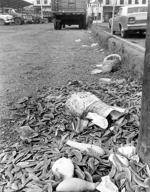
In August 1968, trash was strewn along a street in downtown Richmond. In late June and early July, the eight-day “Fight Litter ’68” campaign gathered a cleanup force of 150 city workers and made progress in seven areas. But the Advertising Club of Richmond planned a follow-up appeal to city residents to join the local fight against litter.
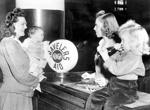
In November 1944, Mrs. Alfred Adkins of Gordo, Ala., and her two young daughters visited the Travelers Aid Society in Richmond en route to Williamsburg, where her military husband was stationed. The society was a charter member of the Richmond War and Community Fund and offered travel assistance to servicemen and civilians.





